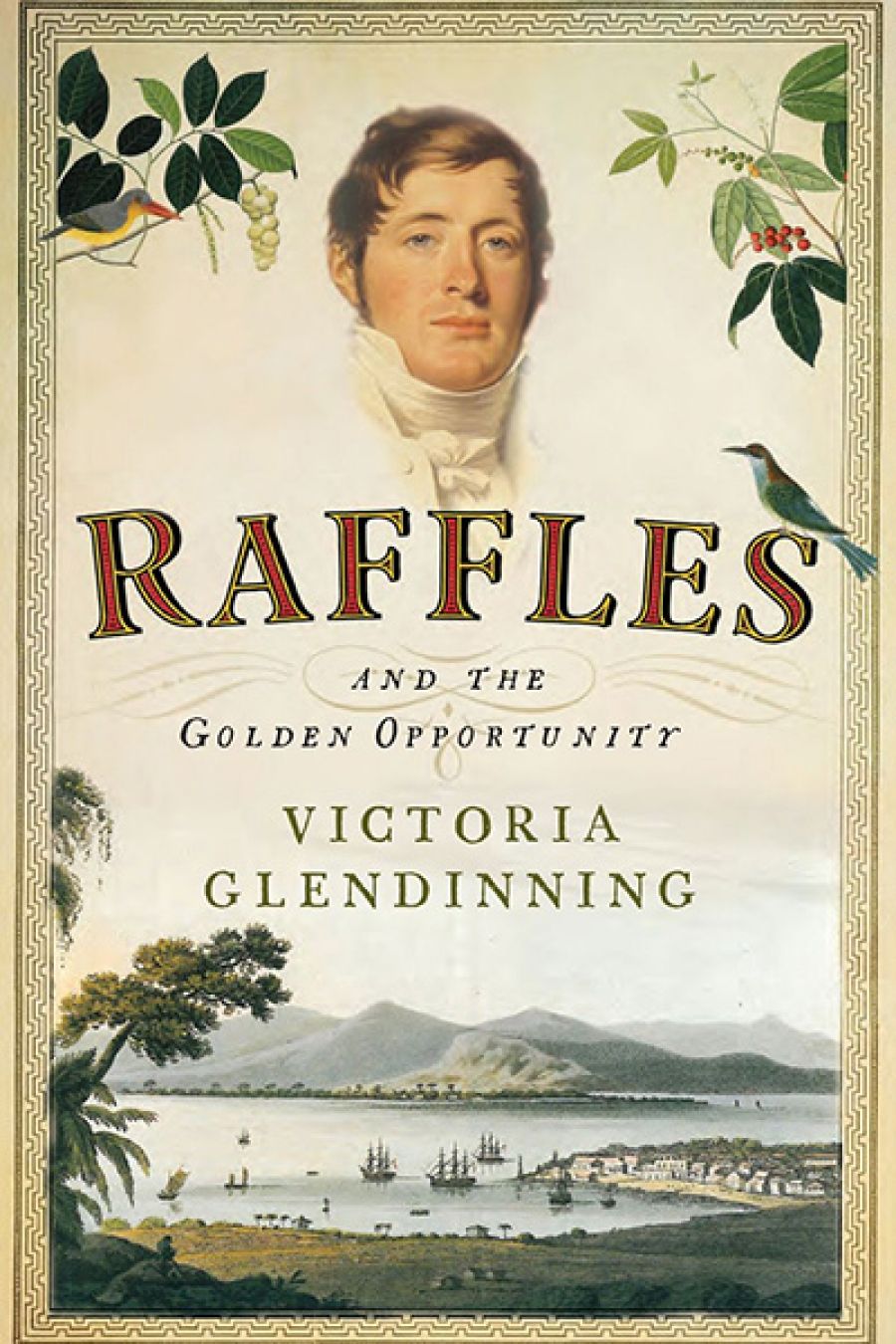
- Free Article: No
- Contents Category: Biography
- Review Article: Yes
- Online Only: No
- Custom Highlight Text:
In 1819, when Lachlan Macquarie was shaping New South Wales, Stamford Raffles established the settlement of Singapore, which was to fulfil his dream of becoming a great eastern ‘Emporium’ and which remains a key trade hub in the Asia Pacific region today. But that is about all most people know about the man who gave his name to so many institutions in the modern city-state, including the eponymous hotel where travellers go to drink Gin Slings.
- Book 1 Title: Raffles and the Golden Opportunity, 1781–1826
- Book 1 Biblio: Profile Books (Allen & Unwin), $45 hb, 366 pp, 9781846686030
Victoria Glendinning turns her hand from acclaimed literary biographies of the Bloomsbury set and Trollope to fill out a wider picture of Raffles, his vaunting ambition and energy, and the failures which came as often as his successes. It is not quite a rags to riches story as, despite midlife success, he was never much good at making money for himself or his employers, and did not end up a wealthy man. Raffles began as a lowly clerk in the East India Company, then the largest employer in Britain. After long years in a Dickensian office in London, he was sent to Penang, making a triumphant return to London in 1816 as governor of Java, which had been temporarily wrested from the Dutch in the Anglo-French wars. He became a popular society figure, was knighted, and made a fellow of the Royal Society, and returned to the East for a further six years, in the course of which he founded Singapore. But his time in fever-ridden South East Asia, then ‘the white man’s graveyard’, cost him his first wife and four of his five children, and he lost much of his wealth when the ship bringing him back to Britain caught fire.
Glendinning is a shrewd guide to the complicated relationships that Raffles formed with those around him, as a relatively rare Englishman in a heavily Scottish milieu at the East India Company. While successfully securing some well-placed patrons, his impetuosity often led to quarrels with older, more experienced Asia hands. It was to prove a damaging flaw, as they queued up to pour vitriol on him at company headquarters in Delhi and London, drawing attention to the occasional and seldom well-executed financial indiscretions intended to enrich himself and his friends. This led to ruinous financial claims against him back in London. Just occasionally, Glendinning projects herself incongruously into the events she describes, such as a meeting with one of his rivals where she conjectures: ‘It is painful to see him, leaning against Palmer’s desk, confiding in that snake.’
Raffles’ establishment of Singapore was not seen as such a great success at the time. In fact, he had got rather ahead of his instructions, so seized was he of the necessity for a trading post midway on the great trade route between India and China. But his bosses, worried about upsetting the Dutch, issued a somewhat half-hearted rebuke referring to ‘the freedom with which you committed your government without their knowledge or authority, to measures which might have brought a war upon them’. Readers may be surprised to learn that in fact Raffles spent only eleven months in Singapore in total, over three separate visits. Much of the work of establishing the new settlement was actually done by his subordinate, William Farquhar, whom Raffles eventually sacked for wearing a sarong at official functions (this was in the days before metrosexual David Beckham made such attire respectable). But the city bears the imprint of Raffles’ vision to this day: from the town plan he mapped out to his insistence that it be a low tax freeport, and his recognition that Chinese settlers were indispensable.
Raffles was clearly an imperialist, but one with a great respect for native history and culture. He learnt the language, sought out local scholars, and travelled widely on expeditions to explore and record the region’s zoology and botany. In his all too brief retirement in London, before dying at forty-five from brain disease, he founded the London Zoo. Glendinning captures well the balance between his personal and colonial ambitions and his desire to do good; for example, he was a friend of William Wilberforce and a lifelong campaigner against slavery. She produces an account of a man who is neither villain nor saint, but who shows occasional touches of genius.
In a fascinating analysis of a man and a period which played a not insignificant role in shaping the history of early modern South-East Asia, Glendinning draws on family papers not available to previous biographers, painting personal portraits with an enjoyable wealth of colour. Her final chapter, ‘What happened to the Others’, is an added bonus; it ties up the stories of a number of the lesser characters who played bit parts in Raffles’ sweeping drama.
We would probably know little of Raffles today were it not for his second wife, Sophia, who, after his death, campaigned for a statue to be raised in his memory in Westminster Abbey, and published at her own expense a lengthy biography and compilation of his papers. All biographers bring their own angle: Sophia wrote the first wife, Olivia, a racy Circassian beauty ten years older than Raffles, completely out of the story. There have been other biographies since, but this new one, surprisingly the first in nearly half a century, looks set to become the standard reference.


Comments powered by CComment